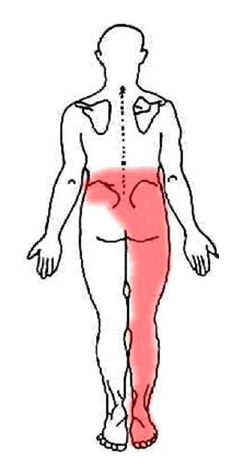Sciatica
 The first known use of the word sciatica dates to 1451.
The first known use of the word sciatica dates to 1451.
Sciatica is a set of symptoms including pain that may be caused by general compression or irritation of one of five spinal nerve roots that give rise to each sciatic nerve, or by compression or irritation of the left or right or both sciatic nerves.
Sometimes you can get muscular compression of the sciatic nerve or muscular trigger points that also refer pain into the back of the leg and thigh.
Symptoms include low back pain, buttock pain, and pain, numbness or weakness in various parts of the leg and foot. Other symptoms include pins and needles or tingling and difficulty in moving or controlling the leg. Typically, the symptoms are only felt on one side of the body. The pain may radiate below the knee, but does not always.
Although sciatica is a relatively common form of low back and leg pain, the true meaning of the term is often misunderstood. Sciatica is a set of symptoms rather than a diagnosis for what is irritating the root of the nerve, causing the pain. The treatment for sciatica or sciatic symptoms often differs, depending upon the underlying cause and pain levels.
What causes Sciatica?
Compression of the sciatic nerve roots caused by a herniated (torn) or protruding disc in the lower back.
Muscular pressure on the sciatic nerve in your buttock (e.g. piriformis syndrome)
Muscular referred leg pain due to trigger points.
Referred pain into the legs from Facet joints and Sacroiliac joints.
Stress – produces hormones in your body that promote inflammation.
The nerve first inflames, then as the compression progresses causing first tingling, then pins and needles, then numbness and muscle weakness.
Very often sciatica may not give low back pain, just leg and buttock pain.
Treatment of Scitica
Medicine
Although medications are commonly prescribed for the treatment of sciatica, evidence for pain killers is poor. Specifically, NSAIDs do not appear to improve immediate pain and all NSAIDs appear about equivalent. Evidence is also lacking in use of opioids and muscle relaxants. In those with sciatica, believed to be due to piriformis syndrome, botulism toxin injections may improve pain and or function
Surgery
Surgery for unilateral sciatica involves the removal of part of the disc, known as a discectomy. While it results in short term benefits, long term benefits appear equivalent to conservative care
Spinal manipulation as carried out by chiropractors
Initially treatment in the first 6–8 weeks should be conservative, like exercises and spinal manipulation, mobilisation, with or without medications.
Moderate quality evidence suggests that spinal manipulation is an effective treatment for acute sciatica.
Epidurals or spinal injections
Good quality of evidence to suggest short-term pain reduction with epidural steroid injections, long-term benefit is controversial
References
- Leininger, Brent; Bronfort, Gert; Evans, Roni; Reiter, Todd (2011). “Spinal Manipulation or Mobilization for Radiculopathy: A Systematic Review”. Physical Medicine and Rehabilitation Clinics of North America 22(1): 105–125.
- Pinto, RZ; Maher, CG; Ferreira, ML; Ferreira, PH; Hancock, M; Oliveira, VC; McLachlan, AJ; Koes, B (2012 Feb 13). Drugs for relief of pain in patients with sciatica: systematic review and meta-analysis. BMJ (Clinical research ed.) 344: e497.
- Valat, JP; Genevay, S; Marty, M; Rozenberg, S; Koes, B (2010 Apr). “Sciatica.”. Best practice & research. Clinical rheumatology 24 (2): 241–52
- Bruggeman, AJ; Decker, RC (2011 Feb). “Surgical treatment and outcomes of lumbar radiculopathy.”. Physical medicine and rehabilitation clinics of North America 22 (1): 161–7

